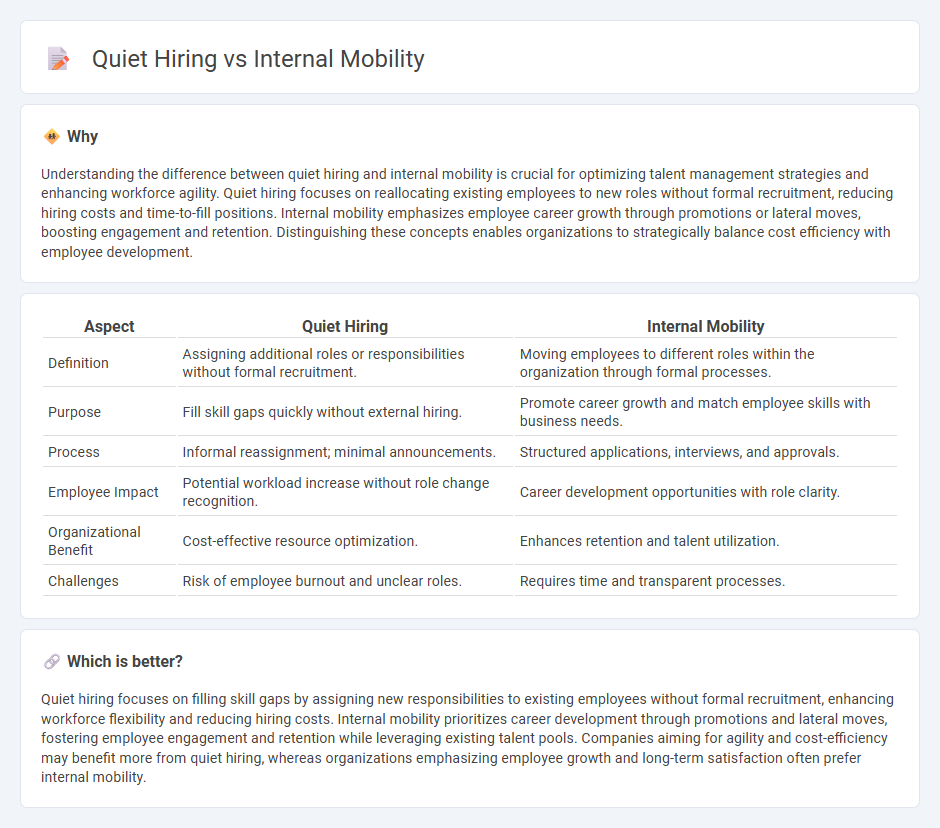
Employers increasingly leverage quiet hiring to fill skill gaps without formal job postings, contrasting with internal mobility, which promotes employee growth through transparent role transitions within a company. Quiet hiring optimizes workforce capabilities by assigning new responsibilities to current staff discreetly, while internal mobility focuses on career development and retention. Explore how these strategies reshape talent management and impact organizational success.
Why it is important
Understanding the difference between quiet hiring and internal mobility is crucial for optimizing talent management strategies and enhancing workforce agility. Quiet hiring focuses on reallocating existing employees to new roles without formal recruitment, reducing hiring costs and time-to-fill positions. Internal mobility emphasizes employee career growth through promotions or lateral moves, boosting engagement and retention. Distinguishing these concepts enables organizations to strategically balance cost efficiency with employee development.
Comparison Table
| Aspect | Quiet Hiring | Internal Mobility |
|---|---|---|
| Definition | Assigning additional roles or responsibilities without formal recruitment. | Moving employees to different roles within the organization through formal processes. |
| Purpose | Fill skill gaps quickly without external hiring. | Promote career growth and match employee skills with business needs. |
| Process | Informal reassignment; minimal announcements. | Structured applications, interviews, and approvals. |
| Employee Impact | Potential workload increase without role change recognition. | Career development opportunities with role clarity. |
| Organizational Benefit | Cost-effective resource optimization. | Enhances retention and talent utilization. |
| Challenges | Risk of employee burnout and unclear roles. | Requires time and transparent processes. |
Which is better?
Quiet hiring focuses on filling skill gaps by assigning new responsibilities to existing employees without formal recruitment, enhancing workforce flexibility and reducing hiring costs. Internal mobility prioritizes career development through promotions and lateral moves, fostering employee engagement and retention while leveraging existing talent pools. Companies aiming for agility and cost-efficiency may benefit more from quiet hiring, whereas organizations emphasizing employee growth and long-term satisfaction often prefer internal mobility.
Connection
Quiet hiring leverages internal mobility by reallocating existing employees to new roles that match evolving business needs, reducing the need for external recruitment. This process enhances workforce agility, optimizes talent utilization, and supports employee development within organizations. Companies practicing quiet hiring achieve cost efficiency and faster talent deployment through strategic internal moves.
Key Terms
Talent Development
Internal mobility leverages existing employee skills by promoting or shifting roles within the organization, fostering talent development and retention. Quiet hiring involves assigning employees to new projects or roles without formal recruitment, enhancing skill acquisition and workforce agility. Explore deeper insights on integrating internal mobility and quiet hiring to optimize talent development strategies.
Role Reassignment
Role reassignment under internal mobility involves strategically moving existing employees to new positions within an organization, optimizing talent utilization. Quiet hiring, by contrast, fills skill gaps through temporary or project-based assignments without expanding the workforce. Explore deeper insights on effective role reassignment and how it compares to quiet hiring strategies.
Skills Gap
Internal mobility leverages existing employees' skills to fill new roles, reducing onboarding time and costs while addressing skill gaps effectively. Quiet hiring involves temporarily acquiring needed skills through flexible arrangements like contractors or freelancers without expanding headcount. Explore how both strategies can optimize your talent management and bridge critical skills gaps in your organization.
Source and External Links
Internal Mobility: What Is It and Why Do You Need It? - Internal mobility is the movement of employees both vertically and horizontally within the same company to new roles or development opportunities, encouraged by embracing role-to-role mobility, experiential learning through internal transfers, and empowering employees to drive their own career growth.
What is Internal Mobility and Why is it Important? - Internal mobility involves moving employees to new careers or roles inside the organization and boosts retention, reduces hiring time, fosters employee development, and helps businesses adapt to changing talent landscapes.
Internal Mobility: An HR Professional's Guide - Internal mobility includes promotions, lateral moves, mentorships, cross-team projects, and job swaps designed to retain employees, save on hiring costs, and enhance diversity and innovation within organizations.
 dowidth.com
dowidth.com